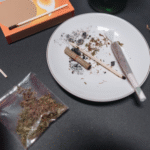
I’ve been collecting kief in my grinder for years now, and I still remember the first time I discovered that golden dust at the bottom of my three-piece. It felt like finding treasure! But after forgetting about a stash for several months, I opened the container to find something that looked… different. Darker, clumpier, and definitely not as aromatic as I remembered.
That experience sent me down a rabbit hole of research about kief preservation that I’ve been building on for the past five years in the cannabis storage industry. If you’re wondering whether that forgotten kief is still good to use, you’re in the right place.
What Exactly Is Kief?
For those new to the term, kief is essentially the collection of trichomes (those tiny crystal-like structures) that fall off cannabis flower. These trichomes are where most of the plant’s cannabinoids and terpenes live, making kief significantly more potent than regular flower, sometimes reaching 50-80% THC compared to flower’s typical 15-30%.
Most people collect kief in the bottom chamber of their grinder, where it sifts through a fine mesh screen. That golden-green powder is pure cannabis goodness, which is why knowing how to store it properly is so important.
Kief vs. Hash and Other Concentrates
Before diving into storage, it’s important to understand how kief differs from other cannabis concentrates:
- Kief is the unprocessed collection of trichomes that naturally separate from the plant material during handling or grinding.
- Hash is kief that has been compressed and sometimes heated, creating a solid product with less oxygen exposure and potentially longer shelf life.
- Rosin is produced by applying heat and pressure to cannabis material (including kief), extracting oils without solvents.
- Solvent-based concentrates like shatter or wax use chemical processes to extract cannabinoids and typically have different storage requirements.
Understanding these differences helps explain why kief has unique preservation challenges compared to other cannabis products.
The Big Question: Does Kief Expire?
The short answer? Yes and no.
Kief doesn’t “go bad” in the same way milk spoils, but it absolutely degrades over time. I’ve seen year-old kief that was still usable but noticeably less potent than fresh stuff. The timeline varies dramatically based on how you store it.
In my experience working with various storage solutions, properly stored kief can maintain good quality for:
- 6-12 months with excellent storage practices
- 3-6 months with decent storage
- Just weeks or a couple months with poor storage
The good news is that even degraded kief isn’t necessarily unusable. It just won’t pack the same punch. The bad news? If moisture gets involved, you could end up with moldy kief that should absolutely be tossed.
What Makes Kief Lose Its Mojo?
After testing countless storage methods with clients and personally, I’ve identified four main culprits that degrade kief quality:
1. Oxygen Exposure
Every time you open your kief container, you’re introducing oxygen that slowly converts THC to CBN (a cannabinoid that’s less psychoactive but more sedative). This chemical transformation is why older cannabis products often make users feel sleepier rather than energized. I cringe when I see people storing kief in containers they open multiple times daily because each exposure accelerates this process.
2. Light Damage
UV light is kief’s worst enemy. I once left a clear glass jar of kief on a windowsill for a week as an experiment. The color changed from golden to brownish, and the potency dropped noticeably. Light breaks down cannabinoids faster than almost anything else by catalyzing oxidation reactions and degrading terpenes, which are responsible for both aroma and some effects.
3. Temperature Fluctuations
Heat speeds up degradation processes significantly. The ideal temperature range for kief storage is 60-70°F (15-21°C). I’ve had customers store kief in their garage during summer, only to find it significantly degraded after temperature swings between 60-100°F. Consistent cool temperatures work best because they slow down the molecular activity that leads to cannabinoid breakdown.
4. Moisture Problems
This is the big one that can make kief actually dangerous to consume. The ideal relative humidity for kief storage is between 55-62%. Above 65% humidity, you risk mold development, which can happen surprisingly quickly in the right conditions. I’ve seen perfectly good collections ruined by storing them in bathrooms or kitchens where steam and humidity are constant issues.
How to Tell If Your Kief Has Gone Bad
Over the years, I’ve developed a quick checklist to assess kief quality:
- Color changes: Fresh kief ranges from light tan to greenish-gold. If it’s turned dark brown, that’s oxidation at work.
- Smell test: Good kief has a strong, pleasant aroma. If yours smells musty or has no smell at all, it’s degraded.
- Texture check: Fresh kief is powdery and slightly sticky. If it’s clumped into hard chunks or feels wet, something’s wrong.
- Visual inspection: Any visible mold (white, gray, or blue fuzzy spots) means it’s trash day for that batch.
- Effect assessment: The ultimate test is potency. If it takes twice as much to get half the effect, degradation has definitely occurred.
I once had a customer bring in a two-year-old kief collection that had turned almost black. It still contained cannabinoids, but the terpenes were completely gone, leaving a flat, one-dimensional experience when consumed.
Storage Solutions That Actually Work
After years of trial and error, here’s what I recommend to keep your kief fresh:
Best Containers
- UV-resistant glass jars: Small, opaque violet or amber glass containers with airtight seals work wonders. The 1-5ml size range is ideal for personal stashes.
- Silicone containers: For smaller amounts (under 2 grams), silicone containers work well because kief doesn’t stick to them, making recovery easier. Just ensure they have a tight seal.
- Stainless steel containers: These provide excellent protection from light and can maintain consistent temperatures better than glass.
- Avoid plastic: Many plastics create static electricity that makes kief difficult to recover, and some can affect flavor over time.
For the absolute best results, consider vacuum-sealed containers specifically designed for cannabis concentrates that remove oxygen from the equation entirely.
Location Matters
I keep my personal stash in a dedicated drawer in my bedroom. It’s dark, maintains a steady temperature, and stays dry. Avoid:
- Refrigerators (humidity issues when opening/closing)
- Windowsills or open shelves (light exposure)
- Bathrooms or kitchens (moisture problems)
- Cars (extreme temperature fluctuations)
- Basements (potential humidity issues in many climates)
My Proven System
For long-term storage of larger amounts, I use this method:
- Split kief into smaller portions (use what you need soon, store the rest)
- Place in small opaque glass jars filled as full as possible (less air space)
- Add a tiny humidity control pack designed for cannabis (58% is ideal)
- Seal tightly and store in a cool, dark drawer or cabinet
- Label with the date (trust me, you’ll forget otherwise)
- If storing over 6 months, consider adding an oxygen absorber packet
This approach has kept kief potent for 12+ months in my testing.
Making the Most of Older Kief
Found some old kief that’s past its prime? Don’t toss it yet! The THC-to-CBN conversion means older kief often produces more relaxing, sleep-friendly effects. I’ve repurposed older kief successfully by:
Cooking and Edibles
- Decarboxylate it (245°F/120°C for 30-40 minutes) before adding to butter or oil
- Use in nighttime edibles where the sedative effects of CBN can be beneficial
- Increase your usual dosage by 25-50% to compensate for potency loss
Smoking and Vaping
- Mix with fresh flower to boost potency while masking any degradation
- Use more of it when adding to bowls or joints (compensating for potency loss)
- Add to lower-quality flower to improve the experience
Concentrates and Extracts
- Press into rudimentary hash (concentrating what goodness remains)
- Use in conjunction with other concentrates to extend supplies
- Create topicals where the exact cannabinoid profile is less critical
Specialized Uses
- Sleep aids (the CBN content makes older kief excellent for insomnia)
- Mix with CBD flower for a balanced, less intense experience
- Create tinctures where flavor is less important than effects
The only exception is moldy kief. That goes straight in the trash. No high is worth respiratory issues or illness.
Quick Comparison: Kief vs. Other Cannabis Products
In my experience, here’s how kief stacks up against other cannabis products in terms of shelf life when stored under optimal conditions:
| Product Type | Optimal Shelf Life | Storage Complexity | Signs of Degradation |
| Kief | 6-12 months | Moderate | Darkening, loss of aroma |
| Flower | 3-6 months | High | Drying out, brittle texture |
| Hash | 1-2 years | Low | Hardening, darkening |
| Rosin | 6-12 months | Moderate | Buddering, texture changes |
| Edibles | 3-6 months | Low | Texture changes, staleness |
| Tinctures | 1-2 years | Very low | Separation, color changes |
Final Thoughts: Respect the Kief
After five years helping cannabis enthusiasts preserve their products, I’ve learned that kief deserves special attention. It represents the most concentrated form of the plant that most home users will encounter without specialized equipment.
Store it right, and you’ll be rewarded with potent, flavorful experiences months down the line. Neglect it, and you’ll be left with a shadow of what could have been.
Remember: dark, cool, dry, and airtight are your watchwords for kief storage. Follow those principles, and your future self will thank you when you discover that perfectly preserved stash you tucked away for a rainy day.
What storage methods have worked best for your kief? I’m always collecting new data points from fellow enthusiasts!





